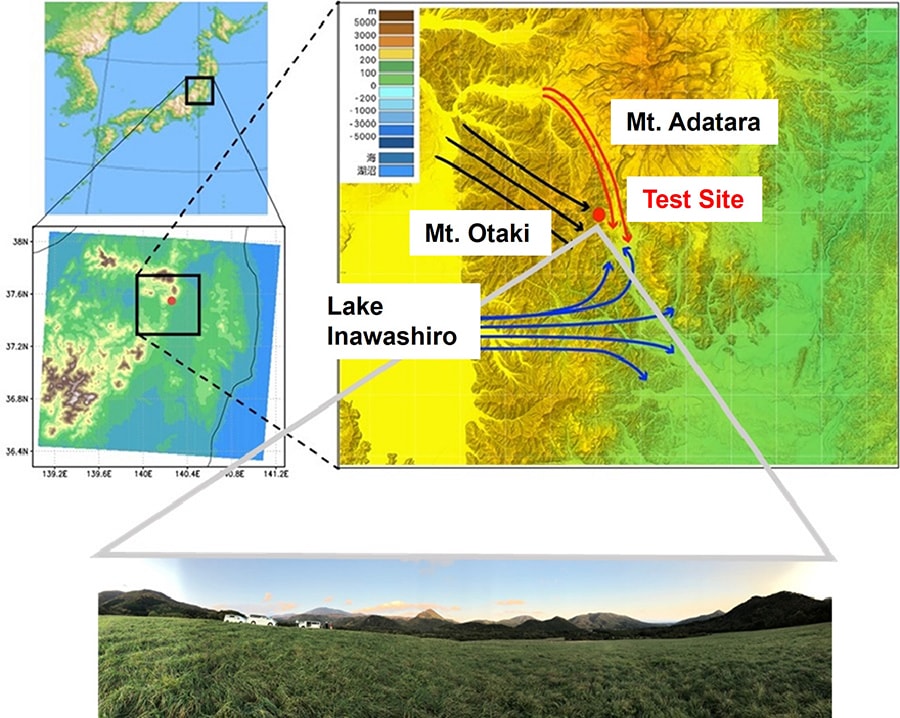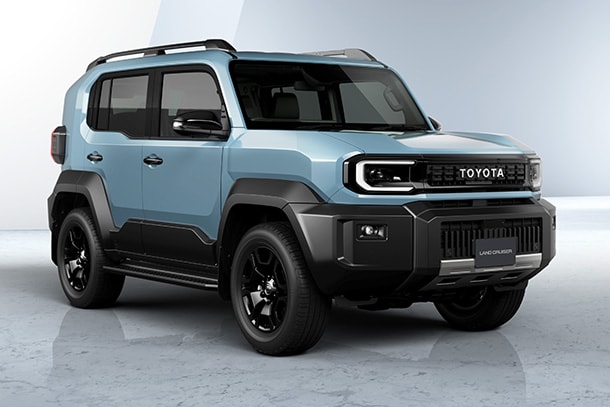Oct. 27, 2023
Aerial Platform "Mothership Project" vol. 2Achieved a robust attitude control system for kites inspired by the flight of birds of prey!
Toyota Motor Corporation abides by the "Five Main Principles of Toyoda," a written statement of the teaching of Sakichi Toyoda, one of which is to "Always be studious and creative, striving to stay ahead of the times." At our Frontier Research Center, we envisage social issues that Japan will face in the future, and in 2018, launched the "Mothership Project"*1-3, for the future energy security of Japan, which is heavily reliant on imported resources. The project conducts research to fly a large kite in the atmosphere's tropopause region, to utilize the westerly jet stream to generate energy and to provide other useful services for the world. In order to realize this project, we have conducted the following:
-
- April 2018
- Project launched.
-
- July 2018
- Design, fabrication, testing, and evaluation of an "inflatable structure" kite.
-
- May 2020
- Achievement of 1,000-meter flight altitude with U.S.-made base material.
-
- March 2021
- Completion of development of "new base material" filled with one-of-a-kind technology to achieve flight at high altitude.
-
- September 2021
- Continuous flight tests using the kite with the new base material. Subsequently, three more in October and November 2021, and March 2022.
-
- March 2023
- Continuous flight tests using the kite with the new control system
-
- September 2023
- 12-hour continuous flight tests
In the last issue of Mothership Project volume 1*4 introduced the development of "new base material" for flight at high altitudes. In this second article, based on the results of the continuous flight test in March 2022, we will introduce the "development of attitude control system" of the kite, which is important to keep the kite in the air for a long time and stabile even under severe wind conditions.
New Base Material is Ready, and a New Goal is in Sight
First, we would like to report the results of the continuous flight test with the kite using the "new base material" conducted in March 2022, as announced in the first article. See Movie 1. As we had expected, the new base material made the kite lighter and strengthened the stitching, which greatly improved the durability and aerial stability of the kite against strong winds, and the inflatable structure did not break during flight. However, due to the short period of stable winds, the flight continued for only 2 hours and 13 minutes, which was far short of the target of 24 hours of continuous flight, letting us experience firsthand how greatly the natural environment can affect test results.
- Movie 1 Continuous flight test performed in March 2022
However, this is our excuse. To realize the Mothership Project, we need to be able to fly the kite from anywhere at any time and keep the kite continuously in the air. Therefore, as our next milestone, we have set our sights on developing a control system that can stay in the air stably for long durations of time, even in locations where strong winds blow all year round.
Simulation Reveals Underlying Causes
During the several continuous flight tests that had been conducted since September 2021, we had been suffering from the so-called "dive and fall" phenomenon, in which the kite loses its balance and falls significantly when it is hit by strong gusts of wind. To solve this phenomenon, we reviewed the structural design of the kite and tried to improve its rigidity and stability (Figure 1), and the gust speeds that the kite could endure were improved from 10 m/s to 20 m/s. However, the speeds in the continuous flight test were higher than those, at 30 m/s, therefore, we were not able to solve the problem of the dive and fall by devising a new structural design.
-

- Figure 1 Evolution of the kite structure (from right to left)
At that time, the dynamics simulation (flight motion model based on the equation of motion) of the kite, which had been under development for three years since the project was launched, was completed, and we immediately simulated it and found that the reason for the dive and fall in a gust of wind was the asymmetric deformation of the left and right wings due to the use of the "inflatable structure" (Figure 2, Movie 2). This is a fundamental technical problem caused by using an "inflatable structure" that is large and light. In order to keep the kite staying in the air for a long time, it is essential to "develop attitude control system" to correct the asymmetry of the left and right wings by using an "aerodynamic rudder."
-

- Figure 2 Example of reproducing asymmetric deformation of left and right wings using dynamics simulation
- Movie 2 Example of kite dynamics simulation when subjected to wind gusts due to asymmetric deformation of the left and right wings
Aerodynamic Rudder and Attitude Control System Development and Overcoming Issues
There are an infinite number of solutions for the configuration of the aerodynamic rudder, but since the rudder is powered by batteries mounted on the kite, it should be small, light, power efficient, and have a large aerodynamic characteristic variation for attitude control. After numerous dynamics simulations and wind tunnel tests, we decided to use the spoiler style of airplane wings and mount them on the left and right wing chords on the top surface of the kite (Figure 3).
-

- Figure 3 Spoilers mounted as aerodynamic rudders
In addition, there is a laboratory*5 at Princeton University in the United States that analyzes the dynamics of living organisms, and because of the interesting research on the flight of birds of prey in that laboratory, Dr. Aimy Wissa of that laboratory and the Toyota Research Institute of North America (TRINA) were conducting a joint research project in 2021. Speaking of birds of prey, their flight dynamics control, such as suddenly reversing their posture from a high altitude and swooping down to catch small animals fleeing on the ground in the woods, might be useful for our kite's attitude control, so we immediately asked TRINA for help.
-

- Figure 4 Covert wings of birds of prey
TRINA explained to us that birds of prey have feathers called "coverts" as shown in Figure 4, which they control as an aerodynamic rudder, and we immediately installed a covert-style aerodynamic rudder on our kite (Figure 5). The results of the dynamics simulation analysis showed that the attitude control system is robust even with wind gusts of about 30 m/s in the simulation.
-

- Figure 4 Covert wings of birds of prey
-

- Figure 5 Covert aerodynamic rudder implementation on a kite
In March 2023, we conducted a continuous flight test of the kite with spoilers and coverts, and achieved 6 hours of stability in the air, even in rough wind conditions (Movie 3, Figure 6).
- Movie 3 Conducting a continuous flight test in March 2023
-

- Figure 6 The kite and the member when 6 hours of continuous flight is achieved
Future Plans
It has been five and a half years since the launch of the Mothership Project, and we are now aware that the project, which started with three people at the beginning, has grown into a project with colleagues all over the world and inquiries from researchers all over the world. In order to continue to improve the performance of the kite and to realize the Mothership Project concept described in the first article, we are currently working with our members to develop an advanced version of the current kite to reach an altitude of 5,000 meters and stay in the air for 8 consecutive days in 2024 as the next goal.
We are also considering services that can contribute to the world as a destination for applications of kites. As an example, we are considering using data collected by kites in the sky to predict potentially severe weather events, such as linear precipitation zones, and to use kites as a means of controlling weather for disaster prevention and mitigation. For the latter, we are involved as a participant in the core research project "Weather Control Living with Guerrilla Downpours and Linear Convective System Downpours*6" of the Moonshot Program Objective 8 (Weather Control)*7, Cabinet Office, Government of Japan.
We will continue in our efforts with our hopes pinned on one day seeing the realization of the Mothership Project.
Extras: In search of a harsh testing location, we finally arrived at Fukushima Prefecture. Introduction of a severe continuous flight test at a "Dojo"
Since about 2/3 of Japan's land area is mountainous, there are many areas where strong winds blow throughout the year. We decided on "a meadow in Atamimachiishimushiro, Koriyama City, Fukushima Prefecture" as a test site after discussing with the Fukushima Prefectural Government, considering several conditions such as easy access from our research base (Shizuoka Prefecture) and the possibility of night flights, as well as the fact that they had been a great help to us since the launch of this project (Figures 7 and 8). The test here was not a simple one, as the area is surrounded by high mountains on three sides, and the seasonal and day-to-night temperature changes are extreme, with occasional storms, snow, and blustery winds that blow in and out of control, making it truly a "Dojo" for training our kite. Conducting continuous flight tests under such severe conditions was a matter of life and death, and we worked with the members of Fukushima Prefecture's "Dojo" to raise the level of continuous flight tests by devising and practicing onsite how to conduct a test safely and efficiently.
-

- Figure 7 Location of the "Dojo" and image of severe wind conditions there
-

- Figure 8 Cold nighttime testing conditions in the "Dojo." When it snowed, the locals volunteered to shovel the snow!
Another important aspect of conducting a continuous flight test is to understand the wind conditions during the flight. Weathernews Inc.*8 provided daily wind condition forecast information for the area of approximately 80 km square and 2,400 m in height around "Dojo" every 300 m in the plane direction and every 50 m from 10 m above ground level in the height direction (Figure 9) during the continuous flight test period, and the continuous flight test plan for the following day was made based on this information. Metro Weather*9 accompanied us throughout our continuous flight test and helped us monitor the wind conditions in real time using a Doppler Lidar (a device that detects sudden changes in wind conditions in the sky) (Figure 10). We would like to take this opportunity to thank them.
Finally, the development of the Mothership Project is introduced in the Toyota Times, serialized in Toyota, Beyond Mobility, "What are Toyota's Kite-Flying Researchers Trying to Achieve?" dated on December 8. Please take a look at this site as well.
-

- Figure 9 Example of precise wind condition forecast information for the area around "Dojo." Generally, wind condition forecast information for urban areas is provided every 5 km on surface direction, so it is easy to understand how precise the data provided by Weathernews was this time. During the continuous flight test period of "Dojo," every time we received a wind condition forecast information from Weathernews, we received a message from them saying, "Please do your best. Your efforts are very encouraging to us"
-

- Figure 10 Simultaneous measurements with the Doppler Lidar (specifications at the time, installed on the cargo bed of the red light truck in the center). We have shared many hardships with Metro Weather and have become friends literally "lived under the same roof"
Acknowledgements
members of Fukushima Prefecture's "Dojo"
- Next Generation Industry Division, Commerce, Industry and Labor Department, Fukushima Prefectural Government
- Ken-chu District Development Bureau, Fukushima Prefectural Government
- Ken-poku District Development Bureau, Fukushima Prefectural Government
- Fukushima City
- ATAMI Society of Commers & Industry
- Ishimushiro Neighborhood Association
- Ishimushiro Ranch Utilization Agricultural Cooperatives
- Fukushima Robot Test Field
Author
Eiji Itakura
Eiji Itakura was a core team member during type certification and production certification missions when Toyota was involved in aircraft engine development. Since then, he has been involved in future mobility planning and research. His dream is the realization of the Mothership Project. Since the Mothership Project is an aggregation of various research and technologies, we are considering whether it can also be a platform for "cutting-edge research and technologies that are not well known to the public at the moment". If you are interested, please contact us.
References
Contact Information (about this article)
- Frontier Research Center
- frc_pr@mail.toyota.co.jp






